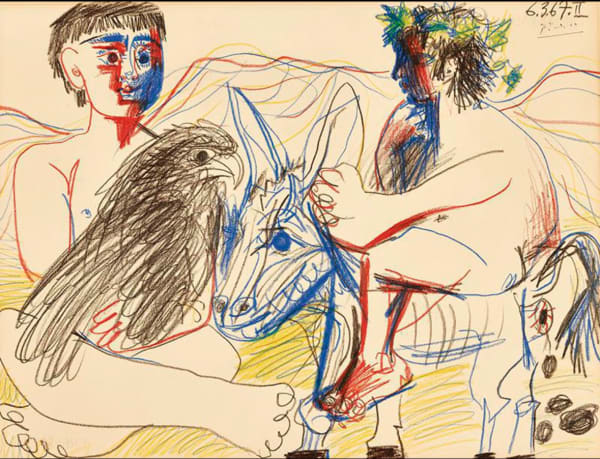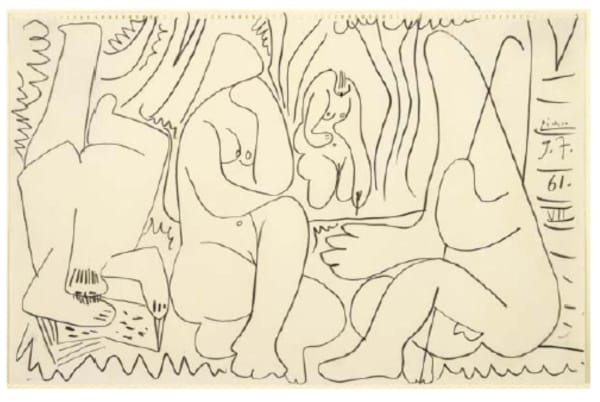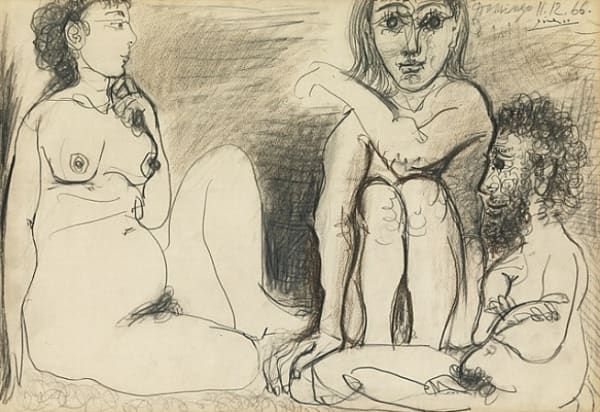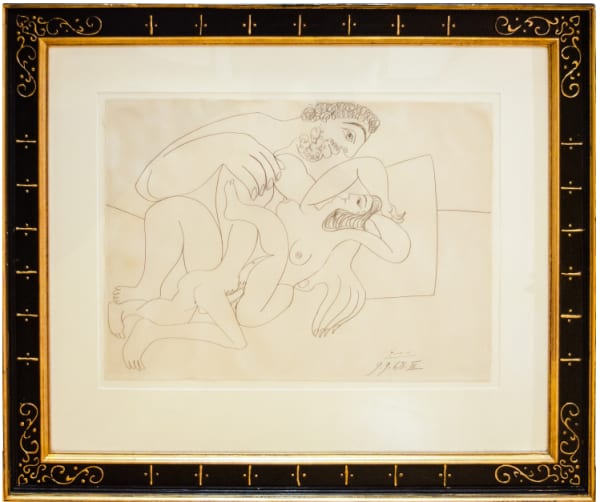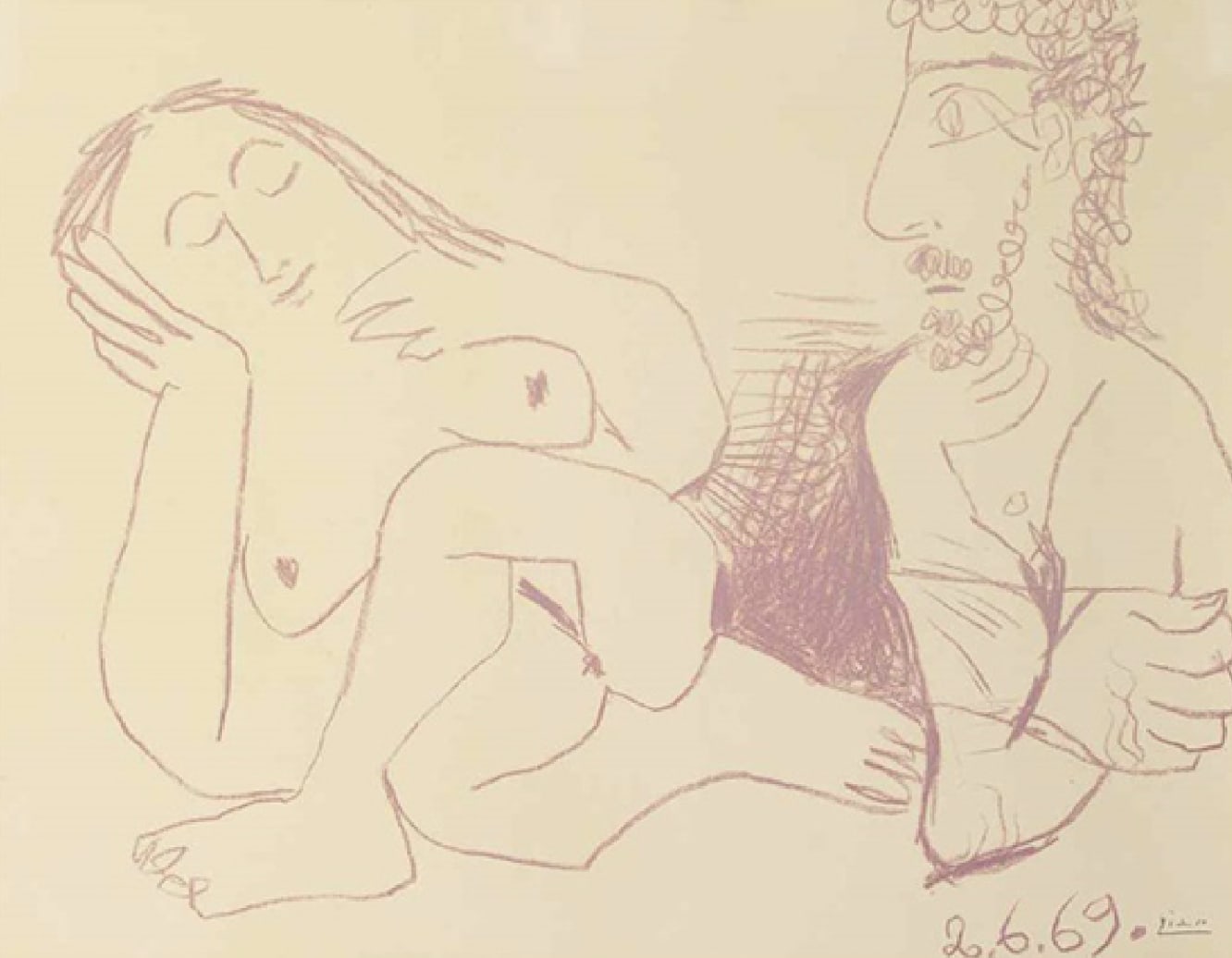
Pablo Picasso
Signed and dated
50.8 x 63.5 cm
Bust of Naked Man and Woman, executed on June 26, 1969, is a vivid example of Pablo Picasso’s late graphic language—raw, spontaneous, and steeped in mythological and erotic energy. Using coloured wax crayon, Picasso transforms a simple medium into a vehicle for expressive immediacy and visual poetry. Created just four years before his death, this work speaks to the enduring vitality of the artist’s vision, even in his late 80s. The drawing is at once minimal and charged with narrative—evoking both classical allusion and the artist’s lifelong fascination with the dynamics between man and woman.
The image presents a reclining nude woman and a partially clothed male figure, both sketched in a purplish wax crayon. The woman lies in a restful, almost fetal pose—eyes closed, one hand propped gently under her head, the other across her chest. Her figure is outlined with flowing, curvilinear lines that express a tender sensuality and inner calm. In contrast, the male figure, seated upright, appears more animated and intensely gazing toward her. His exaggerated facial features—arched nose, curly hair, and beard—are drawn in a caricatural manner, invoking the stylised profiles of ancient Greco-Roman heroes or gods.
Despite its visual economy, the drawing is full of narrative implication. The tension between the man’s upright, observant posture and the woman’s reclined, peaceful state suggests a moment of voyeurism, longing, or contemplation. The simplicity of form—no shading, no background, no color gradients—leaves space for emotional resonance. What’s left is line, gesture, and symbolic archetype.
The flat composition, neutral background, and use of just one colour tone reinforce a sense of timelessness. The soft wax crayon creates a texture between drawing and print, echoing the looseness of Picasso’s lithographs and the intimacy of a personal sketchbook page. Yet this is no casual doodle—it is refined, intentional, and conceptually sophisticated.
The theme of the reclining nude woman observed by a clothed or semi-clothed man recurs frequently in Picasso’s work—across painting, etching, and drawing—from the 1930s through his late years. It reflects not just erotic fixation, but a deeper meditation on the relationship between creation and observation. The male figure here may be read as the artist himself, contemplating his muse—a timeless dynamic in Western art, updated through Picasso’s modernist lens.
Moreover, the man’s stylised head and the woman’s serene curves recall the mythology of Venus and Mars, or even scenes from bacchanalian friezes. In his later years, Picasso often returned to classical subjects with renewed energy, not to replicate antiquity but to reinterpret its themes of love, mortality, and the human condition through his own aging perspective.
This drawing is also a continuation of the intimate, erotic language seen in works like the 156 Series and 347 Series, which Picasso created in bursts of manic creativity during the late 1960s and early 1970s. These series are filled with images of artists, lovers, satyrs, and muses—fusing the autobiographical with the mythological.
Bust of Naked Man and Woman exemplifies the bold clarity of Picasso’s late period. Through minimal means—just wax crayon on paper—he evokes centuries of art historical tradition, compressing sensuality, myth, and psychological presence into a few simple lines. It is both a meditation on human intimacy and a final flourish of artistic mastery, showing that even in his final years, Picasso remained a tireless innovator, ever probing the essence of human connection with fresh vision.
For more information, contact our galleries via the inquiry form below.
-
 Pablo PicassoThe Foot Bath | Le Bain de pieds, 1960
Pablo PicassoThe Foot Bath | Le Bain de pieds, 1960 -
 Pablo PicassoFemme tenant un journal, 1915
Pablo PicassoFemme tenant un journal, 1915 -
 Pablo PicassoTrois Personnages,, 1954
Pablo PicassoTrois Personnages,, 1954 -
 Pablo PicassoQuatre têtes d’élégantes (Four Elegant Heads), c. 1899
Pablo PicassoQuatre têtes d’élégantes (Four Elegant Heads), c. 1899 -
 Pablo PicassoLes déjeuners,, 1961
Pablo PicassoLes déjeuners,, 1961 -
 Pablo PicassoTête de faune, 1958
Pablo PicassoTête de faune, 1958 -
 Pablo PicassoTeenager, eagle and donkey, 1967
Pablo PicassoTeenager, eagle and donkey, 1967 -
 Pablo PicassoTrois hommes et femme nus, 1967
Pablo PicassoTrois hommes et femme nus, 1967 -
 Pablo PicassoHomme Assis, 1971
Pablo PicassoHomme Assis, 1971 -
 Pablo PicassoLes Dejeuners, 1961
Pablo PicassoLes Dejeuners, 1961 -
 Pablo PicassoTrois Personnages nus Assis, 1966
Pablo PicassoTrois Personnages nus Assis, 1966 -
 Pablo PicassoHomme et Femme, 1926
Pablo PicassoHomme et Femme, 1926 -
 Pablo PicassoL’Etreinte, 1968
Pablo PicassoL’Etreinte, 1968 -
 Pablo Picasso·Toros, 1961
Pablo Picasso·Toros, 1961 -
 Pablo Picasso·Étude pour la Suite Des Déjeuners III, 1959
Pablo Picasso·Étude pour la Suite Des Déjeuners III, 1959 -
 Pablo PicassoLe déjeuner, 1962
Pablo PicassoLe déjeuner, 1962 -
 Pablo PicassoLes déjeuners,, 1961
Pablo PicassoLes déjeuners,, 1961
Join our mailing list
* denotes required fields
We will process the personal data you have supplied in accordance with our privacy policy (available on request). You can unsubscribe or change your preferences at any time by clicking the link in our emails.
This website uses cookies
This site uses cookies to help make it more useful to you. Find out more about cookies.






